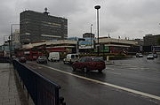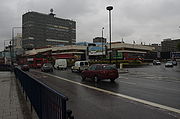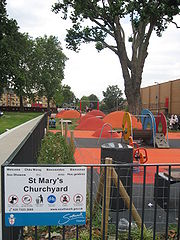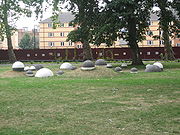
Newington Butts
Encyclopedia



London Borough of Southwark
The London Borough of Southwark is a London borough in south east London, England. It is directly south of the River Thames and the City of London, and forms part of Inner London.-History:...
, that gives its name to a segment of the A3 road
A3 road
The A3, known as the Portsmouth Road for much of its length, is a dual carriageway, or expressway, which follows the historic route between London and Portsmouth passing close to Kingston upon Thames, Guildford, Haslemere and Petersfield. For much of its length, it is classified as a trunk road...
running south-west from the Elephant and Castle
Elephant and Castle
The Elephant and Castle is a major road intersection in south London, England, located in the London Borough of Southwark. It is also used as a name for the surrounding area....
junction. The road forks left into Kennington Park Road
Kennington Park Road
Kennington Park Road is a main road in south-east London, England, and is part of the A3 trunk road. It runs from Newington Butts at its Y-junction with Kennington Lane, south-west to the Oval, where the A3 continues as Clapham Road, towards Stockwell...
and right into Kennington Lane, leading to Kennington
Kennington
Kennington is a district of South London, England, mainly within the London Borough of Lambeth, although part of the area is within the London Borough of Southwark....
and Vauxhall Bridge
Vauxhall Bridge
Vauxhall Bridge is a Grade II* listed steel and granite deck arch bridge in central London. It crosses the River Thames in a south–east north–west direction between Vauxhall on the south bank and Pimlico on the north bank...
respectively.
It is popularly believed to take its name from an archery butts
Archery butts
An archery butts is an archery practice field, with mounds of earth used for the targets. The name originally referred to the targets themselves, but over time came to mean the platforms that held the targets as well. For instance Othello, V,ii,267 mentions "Here is my journey's end, here is my...
, or practice field, but there is no evidence for such activity. The area gave its name to an Elizabethan theatre which saw the earliest recorded performances of some Shakespearean plays.
Toponymy
The Middle English word "butt" referred to an abutting strip of land, and is often associated with medieval field systems. Contrary to popular belief, the 1955 Survey of London published by London County Council could find no historical reference to archery butts in Newington. It concluded that the name probably derived from the triangle of land between the roads, as the word "butts" is used elsewhere in Surrey to refer to odd corners or ends of land.History
NewingtonNewington, London
Newington is a district of London, England, and part of the London Borough of Southwark. It was an ancient parish and the site of the early administration of the county of Surrey...
was a rural village that grew up on the Walworth Road at its junction with the Portsmouth Road
A3 road
The A3, known as the Portsmouth Road for much of its length, is a dual carriageway, or expressway, which follows the historic route between London and Portsmouth passing close to Kingston upon Thames, Guildford, Haslemere and Petersfield. For much of its length, it is classified as a trunk road...
, about a mile south of London Bridge
London Bridge
London Bridge is a bridge over the River Thames, connecting the City of London and Southwark, in central London. Situated between Cannon Street Railway Bridge and Tower Bridge, it forms the western end of the Pool of London...
. Being outside the jurisdiction of the City of London
City of London
The City of London is a small area within Greater London, England. It is the historic core of London around which the modern conurbation grew and has held city status since time immemorial. The City’s boundaries have remained almost unchanged since the Middle Ages, and it is now only a tiny part of...
it became home to activities such as plays that were banned near London during hot weather, for fear of spreading infection.
In the 17th and 18th centuries, the triangle of ground between the roads was known as the Three Falcons and was copyhold
Copyhold
At its origin in medieval England, copyhold tenure was tenure of land according to the custom of the manor, the "title deeds" being a copy of the record of the manorial court....
of the manor of Walworth. In 1791 the leading scientist Michael Faraday
Michael Faraday
Michael Faraday, FRS was an English chemist and physicist who contributed to the fields of electromagnetism and electrochemistry....
was born at Newington Butts. In 1802, Thomas Hardwick reported that the estate consisted of a number of small tenements in bad condition.
In the spring of 2008, St Mary's Churchyard, the green open space on the northern border of Newington Butts, was given a face lift. The largely grassy area now contains a children's playground. Dotted about within the playground and on the grass elsewhere are concrete mounds with rubber (safety) surfaces which were designed to add interest and topography to the developed area. These mounds might recall archery butts
Archery butts
An archery butts is an archery practice field, with mounds of earth used for the targets. The name originally referred to the targets themselves, but over time came to mean the platforms that held the targets as well. For instance Othello, V,ii,267 mentions "Here is my journey's end, here is my...
but this has been denied by the Elephant and Castle
Elephant and Castle
The Elephant and Castle is a major road intersection in south London, England, located in the London Borough of Southwark. It is also used as a name for the surrounding area....
Regeneration Team.
In Cockney rhyming slang
Cockney rhyming slang
Rhyming slang is a form of phrase construction in the English language and is especially prevalent in dialectal British English from the East End of London; hence the alternative name, Cockney rhyming slang...
'Newington Butts' means 'guts'.
Theatre
The Newington Butts Theatre was one of the earliest Elizabethan theatres, possibly predating even The TheatreThe Theatre
The Theatre was an Elizabethan playhouse located in Shoreditch , just outside the City of London. It was the second permanent theatre ever built in England, after the Red Lion, and the first successful one...
of 1576 and the Curtain Theatre
Curtain Theatre
The Curtain Theatre was an Elizabethan playhouse located in Curtain Close, Shoreditch , just outside the City of London. It opened in 1577, and continued staging plays until 1622....
, which are usually regarded as the first dedicated playhouses in London. William Ingram believes it was probably the first of the three to begin construction, and may have been the first completed.
The Mayor and Corporation of London banned plays in 1572 as a measure against the plague, and in 1575 they formally expelled all players from the city. This prompted the construction of playhouses outside the jurisdiction of London, in the liberties
Liberty (division)
Originating in the Middle Ages, a liberty was traditionally defined as an area in which regalian rights were revoked and where land was held by a mesne lord...
of Halliwell (in Shoreditch) and later the Clink
Liberty of the Clink
The Liberty of the Clink was an area in Southwark, on the south bank of the River Thames, opposite the City of London. Although situated in Surrey the liberty was exempt from the jurisdiction of the county's high sheriff and was under the jurisdiction of the Bishop of Winchester who was usually...
, and at Newington near the established entertainment district of St. George's Fields. The Newington theatre was located not on Newington Butts but on the east side of Walworth Road near the junction with New Kent Road. The playhouse stood less than an acre of land in Lurklane, occupying 48 yards of frontage on what became Walworth Road and bounded to the south by a drainage ditch (or "sewer" in the language of the time). Ingram uses Commissions of Sewers records of 1576–1578 to deduce that the actor Jerome Savage lived adjacent to the sewer and thus the playhouse was in the northern part of the plot. The Reliance Building used to occupy the site; it is now under the southern roundabout of the Elephant and Castle junction.
Lurklane was 10 out of 35 acres (141,640.1 m²) leased in 1566 from the Dean and Chapter
Dean of Canterbury
The Dean of Canterbury is the head of the Chapter of the Cathedral of Christ Church, Canterbury, England. The office of dean originated after the English Reformation, and its precursor office was the prior of the cathedral-monastery...
of Canterbury Cathedral
Canterbury Cathedral
Canterbury Cathedral in Canterbury, Kent, is one of the oldest and most famous Christian structures in England and forms part of a World Heritage Site....
by Richard Hick(e)s. Hicks was a grocer
Worshipful Company of Grocers
The Worshipful Company of Grocers is one of the 108 Livery Companies of the City of London. It is ranked second in the order of precedence of the Companies and, having been established in 1345, is one of the original Great Twelve City Livery Companies....
and member of the royal retinue, sometimes described as a "yeoman of the guard". Hicks sublet Lurklane to Jerome Savage on or about Lady Day (25 March) 1576, some three weeks before the lease was signed for The Theatre
The Theatre
The Theatre was an Elizabethan playhouse located in Shoreditch , just outside the City of London. It was the second permanent theatre ever built in England, after the Red Lion, and the first successful one...
in Shoreditch
Shoreditch
Shoreditch is an area of London within the London Borough of Hackney in England. It is a built-up part of the inner city immediately to the north of the City of London, located east-northeast of Charing Cross.-Etymology:...
. However, soon after the 1576 lease was signed, Hicks and his son-in-law Peter Hunningborne tried to rescind it. They failed to do so through the courts, but used trickery to make Savage default on his rent on Lady Day 1577. Savage appears to have stayed on the premises, and in turn sought the protection of the law as Hunningborne sought to move into Savage's residence. Hunningborne described Savage as "a verrie lewed fealowe" who "liveth by noe other trade than playinge of staige plaies and Interlevdes". However the sewer assessments indicate that Savage remained on the premises, so the lawsuit may have been withdrawn or settled out of court.
Wickham et al interpret these documents to mean that Hicks constructed a 'house or tenement' that someone (presumably the actor Savage) converted into a playhouse. It was clearly established by Lady Day 1577 and like the Theatre may have been in use before the winter of 1576/77, or even in 1575. Savage may have built the theatre under the patronage of the Earl of Warwick
Ambrose Dudley, 3rd Earl of Warwick
Ambrose Dudley, 3rd Earl of Warwick, KG was an English nobleman and general, and an elder brother of Queen Elizabeth I's favourite, Robert Dudley, Earl of Leicester...
whose company of actors first performed at court on 14 February 1575. Warwick had been appointed to the Privy Council in the autumn of 1573, and the more powerful privy councillors – the earls of Sussex
Sussex's Men
The Earl of Sussex's Men was a playing company or troupe of actors in Elizabethan and Jacobean England, most notable for their connection with the early career of William Shakespeare.-First phase:...
, Lincoln
Edward Clinton, 1st Earl of Lincoln
Edward Fiennes, 1st Earl of Lincoln, KG, also known as Edward Clinton was an English nobleman and Lord High Admiral.-Background:...
, Arundel
Henry FitzAlan, 19th Earl of Arundel
Henry FitzAlan, 19th Earl of Arundel was an English nobleman, who over his long life assumed a prominent place at the court of all the later Tudor sovereigns, probably the only person to do so.-Court career:...
and his younger brother Robert Dudley, Earl of Leicester
Leicester's Men
The Earl of Leicester's Men was a playing company or troupe of actors in English Renaissance theatre, active mainly in the 1570s and 1580s in the reign of Elizabeth I...
– were all patrons of playing companies.
Warwick's company appears to have flourished for around five years, before ill-health forced him to retire to his home in Herfordshire. On 13 May 1580 the Privy Council wrote to the Surrey justices about an unknown company playing at Newington Butts despite a ban on theatre. It is known that John and Lawrence Dutton led members of Warwick's company to reform as the Earl of Oxford
Edward de Vere, 17th Earl of Oxford
Edward de Vere, 17th Earl of Oxford was an Elizabethan courtier, playwright, lyric poet, sportsman and patron of the arts, and is currently the most popular alternative candidate proposed for the authorship of Shakespeare's works....
's players by April 1580, and Ingram speculates that it was they who were playing at their old home. Oxford was sent to the Tower of London
Tower of London
Her Majesty's Royal Palace and Fortress, more commonly known as the Tower of London, is a historic castle on the north bank of the River Thames in central London, England. It lies within the London Borough of Tower Hamlets, separated from the eastern edge of the City of London by the open space...
in 1581, banished from court until 1 June 1583 and went off to war in Flanders in 1585. John Dutton left for the newly-formed Queen's Men
Queen's Men
The Queen's Men was an Elizabethan playing company that operated between 1583 and 1595. It was a popular company and its patron was Queen Elizabeth I...
in 1583 but Oxford's Men survived the loss of their leader, being recorded in each year 1584–1587 and leaving traces of activity thereafter.
A sewer record of 26 February 1591 refers to Hunningborne and the playhouse. By that time it seems to have been in decline, as more theatres sprung up closer to London. Some time in the early 1590s (and definitely before September 1593) Lord Strange's Men
Lord Strange's Men
Lord Strange's Men was an Elizabethan playing company, comprising retainers of the household of Ferdinando Stanley, Lord Strange . They are best known in their final phase of activity in the late 1580s and early 1590s...
played three days there, but the undated Privy Council document comments on the inconvenience of its location and "of longe tyme plaies haue not there bene vsed on working daies". Plague closed down London's theatres for most of the period between 22 June 1592 and 14 May 1594. The impresario Philip Henslowe
Philip Henslowe
Philip Henslowe was an Elizabethan theatrical entrepreneur and impresario. Henslowe's modern reputation rests on the survival of his diary, a primary source for information about the theatrical world of Renaissance London...
took the opportunity to remodel his Rose Theatre
The Rose (theatre)
The Rose was an Elizabethan theatre. It was the fourth of the public theatres to be built, after The Theatre , the Curtain , and the theatre at Newington Butts The Rose was an Elizabethan theatre. It was the fourth of the public theatres to be built, after The Theatre (1576), the Curtain (1577),...
, but for some reason the Privy Council kept it closed from 16 May to 15 June 1594.
Accordingly Henslowe promoted a series of plays at Newington Butts from 3–13 June 1594 with the Admiral's Men
Admiral's Men
The Admiral's Men was a playing company or troupe of actors in the Elizabethan and Stuart eras...
and Lord Chamberlain's Men
Lord Chamberlain's Men
The Lord Chamberlain's Men was a playing company for whom Shakespeare worked for most of his career. Formed at the end of a period of flux in the theatrical world of London, it had become, by 1603, one of the two leading companies of the city and was subsequently patronised by James I.It was...
, the two companies that had emerged from Lord Strange's men during the layoff. The nature of Henslowe's relationship with Newington Butts is uncertain, Vickers among others has suggested Henslowe owned it by this time but Wickham et al speculate that the poor profits he recorded for the season were in part due to the cost of renting the theatre. The ownership theory might be bolstered by Winifred Frazer's suggestion that the enigmatic abbreviation 'ne' used by Henslowe in his records of certain plays applies to a performance at Newington, Conventionally 'ne' is taken to mean a new play, but there are other possible explanations.
This season of plays in June 1594 is well documented, as Henslowe kept assiduous records in his "Diary". These include some of the earliest known performances of familiar names such as Hamlet
Hamlet
The Tragical History of Hamlet, Prince of Denmark, or more simply Hamlet, is a tragedy by William Shakespeare, believed to have been written between 1599 and 1601...
, Titus Andronicus
Titus Andronicus
Titus Andronicus is a tragedy by William Shakespeare, and possibly George Peele, believed to have been written between 1588 and 1593. It is thought to be Shakespeare's first tragedy, and is often seen as his attempt to emulate the violent and bloody revenge plays of his contemporaries, which were...
and The Taming of a Shrew but in each case the exact relationship between the 1594 plays and those we know as Shakespeare's is uncertain and controversial among scholars. Rutter regards the Titus put on by Henslowe at the Rose in January 1594 as "almost certainly Shakespeare's", but it is very early for the Hamlet of the Second Quarto and First Folio
First Folio
Mr. William Shakespeares Comedies, Histories, & Tragedies. is the 1623 published collection of William Shakespeare's plays. Modern scholars commonly refer to it as the First Folio....
, which is ascribed to around 1600. This and other evidence has led to the theory that the 1600 text is based on an earlier play, the so-called "Ur-Hamlet
Ur-Hamlet
The Ur-Hamlet is the name given to a play mentioned as early as 1589, a decade before most scholars believe Shakespeare composed Hamlet...
", which was written by either Thomas Kyd, Shakespeare, or someone else. This performance is the first one on record of Ur-Hamlet, although it appears to have existed since at least 1589.
On 6 July 1594 the Dean and Chapter let the playhouse site to Paul Buck, on condition that he convert the playhouse to other uses and that no more plays were performed after Michaelmas
Michaelmas
Michaelmas, the feast of Saint Michael the Archangel is a day in the Western Christian calendar which occurs on 29 September...
(29 September). Buck seems to have complied – there is no mention of the playhouse in the renewal of his lease on 5 April 1595, and on 5 October 1599 the Sewer Commission refers to "the houses where the old playe house did stand att Newington". The theatrical links lingered after the theatre was gone; a bad pun is referred to as a "Newington conceit" in a play of 1612 and the playwright Thomas Middleton
Thomas Middleton
Thomas Middleton was an English Jacobean playwright and poet. Middleton stands with John Fletcher and Ben Jonson as among the most successful and prolific of playwrights who wrote their best plays during the Jacobean period. He was one of the few Renaissance dramatists to achieve equal success in...
died there and was buried at Newington Butts church on 4 July 1627.
External links
- Newington Butts, Kennington photograph, c. 1870

